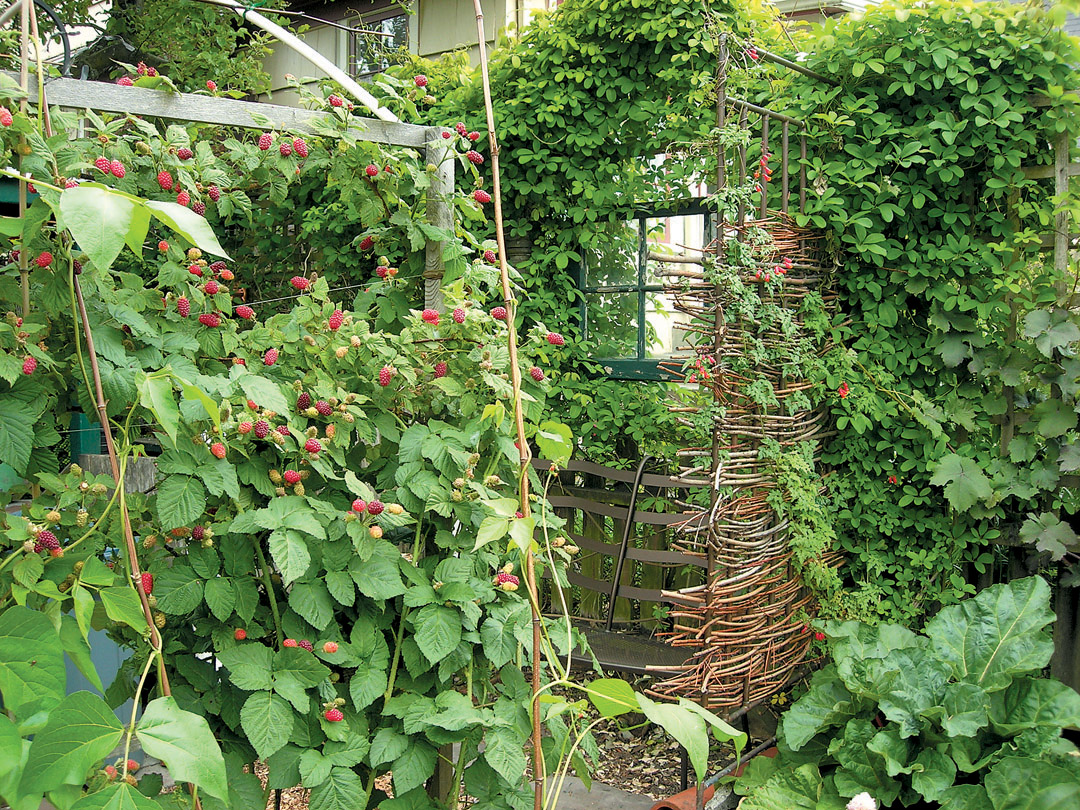
The Oku Stone

Contributor

A willingness to linger is key to understanding the concept of the Oku stone, a Japanese gardening term alluding to a “third stone” that is buried in the garden and not visible. It embodies a less obvious dimension to a garden design, a way of seeing—call it depth perception—and a metaphor for the ability of a garden to disclose the presence and underlying ideas of its creator.
It would be altogether apt to say that the gardens of Julie King and Paul Smith are both enriched by a metaphorical Oku stone. Though perhaps not actually present in the ground of their simple Seattle garden plots, the Oku stone reflects their shared sense of the history of garden design and their respective skills at layering deep meaning into their always evolving creations. They use many of the same plants, but toward different ends. A borrowing from many artistic traditions links their thinking. Both gardeners have a sense of whimsy that I attribute to their coming of age in the sixties when a funk aesthetic dominated West Coast painting as well as crafts. But also present is a respect for carefully composed herbaceous borders in the English tradition. That sense of the Oku stone hidden beneath gives the visitor a deeper experience, beyond the superficial. The Oku stone enlivens the whimsical, eccentric, seemingly irrational aspects of the two gardens.
Both Paul and Julie use a number of visual cues from Japanese garden design that are embedded in West Coast traditions, including borrowed views and dry gardens that suggest the relationship of water and land through the raking of gravel and placement of stone. The Oku stone is like the magnetic pole that orients the metal filings on a sheet of paper; the paper hides the force field’s source. In these two gardens, the owners’ commitments to staying in place long enough to see the results of twenty seasons of growth makes the changes pivot around the pole of the Oku stone. Knowing the placement of rock, tree, or shrub is grounded in what each has learned about their own particular place over time.

Together but Separate
Paul and Julie have moved into their second decade as a couple living apart. Both of their gardens have aged beautifully into something profoundly moving. Their shared history as a couple, traveling and botanizing together but creating gar- dens separated by a thirty minute walk, is unusual. Their respective Seattle neighborhoods (Wallingford and the University District) are unpretentious.
Paul Smith moved to the West Coast from New Jersey in the seventies, picked apples east of the Cascades and in New Zealand, skied and hiked on three continents, before designing and installing gardens for Seattle City Light substations. Julie King grew up in Kirkland, a suburb of Seattle, in a family of lawyers, attended Stanford University, and studied visual arts. She then became a sign painter, before designing gardens and playing music professionally. Both continue to work full-time: Paul as a senior gardener for Seattle Parks at the University of Washington Botanical Garden, Julie as a graphic designer for a Trader Joe’s grocery store.
Together they have traveled to Oregon, California, and England visiting nurseries, gardens, beaches, and mountains. Their shared love of camping, skiing, and botanizing grounds their relationship. Composed and edited over time, the two gardens reflect the personal histories of their owners. Both Paul and Julie are committed to careful documentation and hands-on construction of their gardens, uncompromised by what the Joneses think, what the spouse wants, or the kids need. To keep garden, rather than to keep house, is their preference. Both are ruthless editors and eliminate plants and other elements that do not conform to the vision they have for their respective gardens.
Paul’s property is hidden from the street and surrounded by tall fences and big trees. It slopes to the south and east in Wallingford, providing him with good light in spite of huge trees on three sides. Julie’s corner lot faces south and west; flat and completely level with the street, it has good light most of the day.

The ground plane of each garden is quite different. Paul set sandstone cobbles into low terraces that rise up to the western fence line. Julie has a U-shaped garden that undulates, breaking up the rhythm of walking with no more than a three-inch rise in elevation. The main path swings slightly left, then right as it tracks to the west, giving one a softer experience of the bed’s edges. Paul uses blue glass cullet mixed with pea gravel for his paths; the beds are mulched with various materials. Julie uses gravel to create beachfronts for xeric landscapes in her parking strips; Paul uses gravel to create scree beds. It is the differing way in which the eye travels across the paths to the plants that marks their individual artistry. There are no particular rules of the road, no rigid formulas for edging, but each spends time creating good transitions on the ground plane.

The Importance of Light
One idea they share is the importance of using light to intensify colors, to reflect and frame views, playing light against dark. Paul is the more extreme in his use of highly contrasting color palettes. Eric Krag, a neighbor and talented artist, cast a six-foot-tall, poured glass plinth of compound leaves, which glows in the evening light and is the focal point beneath a large specimen of Crinodendron patagua. The plinth has made a dry, shady spot brighter, as it captures and refracts light from the west in the late afternoon. A mat of purple-leafed Acaena inermis ‘Purpurea’ cascades like port wine over the edge of the scree, a tableau of cutlery, rail- road spikes, and up-ended mica slabs from Vancouver Island. The scale of the scree makes one think of a mining camp in the Cascades, but with a clump of South African Rhodohypoxis baueri poking up thru the granite chips—a bright pink splash in a rather austere setting.
Julie’s use of light and dark is different; she has suspended a window in her garden that frames the view out to the neighbor’s garden in transmitted light, and obscures the same view as morning light catches and refracts the dust on the glass. Correct plant placement is a key to harvesting light. Her palette of warm-to-cool oranges, reds, and golds starts to intensify at sunset, as the raking light pen- etrates the purple bronze leaves of smoke tree (Cotinus coggygria ‘Purpurea’) and ninebark (Physocarpus opulifolius DIABOLO), causing them to glow. This is an ephemeral moment as the sub-merged light intensifies the reds and golds. Adding to the drama at nightfall are the black-throated, crimson flowers of breadseed poppies (Papaver somniferum) that seed themselves throughout the dahlia beds. A purple morning glory (Ipomoea) winds throughout the area.
Paul edits on a grand scale by removing trees that fail to meet his criteria, and pruning hedges of laurel (Prunus laurocerasus); he seldom hesitates in his use of shears and shovel. Julie puts more emphasis on closer connections, on intimate relationships, and on a density of plantings woven together with vines and colors like cadmium oranges and reds. Both fragrance and sound help to deepen the warp and weft of her designs: Lilium ‘Copper King’ is intensely fragrant in the morning; perfectly pitched wind-chimes add to the mood. Hers is a musician’s garden.

Sharing and Borrowing
Some of their ideas are shared; some are borrowed from gardens they admire. The idea for an espaliered Itea ilicifolia climbing Julie’s chimney originated in Roy Lancaster’s garden. The repetition of round shapes can be seen in many other gardens, but the linear use of foliage plants, like the troupe of tall, slender juvenile Pseudopanax ferox pirouetting through space, is uniquely Paul’s. His distinctly austere and calligraphic use of line is muscular and masculine. Julie emphasizes more horizontal lines, like purple morning glory looping about the dahlias and the canary creeper (Tropaeolum peregrinum) intertwined in the Itea. She is fond of scrims as foils for vines; these vertical trellises hold tayberries (Rubus fruticosus x idaeus), scarlet runner beans, a zucchetta summer squash, and tomatoes—simultaneously. Their red points of light reflect the poppies’ color but on a vertical plane.

I never noticed the cruciform pattern of Paul’s paths until he pointed out that the crux is a seating area that divides the ground plane and softens the core of his garden. There are seating areas along the perimeter as well, but the heart of the garden is the central seating area. Julie places seating as “stations of the cross:” arborized benches are tucked into alcoves and over-hung with vines. Throughout the garden, a fountain motif, using vintage galvanized cans spouting colored water, is repeated in the finials on fence posts. Neither gardener hides the working guts of the garden, instead organizing terra cotta pots or weed buckets into pleasing compositions. The blurring of the workbench into display areas is intriguing in both gardens, but Julie’s is less rustic than Paul’s.

Paul’s seating areas are also carefully orchestrated to provide view corridors with tall trees as the focal points: a Norway spruce (Picea abies) in the neighbor’s garden, a eucalyptus to the south, the central Crinodendron with its large crown hung with pendulous white flowers. Each tree holds together a section of the garden, with the mid-story augmented by potted plants. His warm-to-cool color palette is under- pinned with a ground plane of rocks, gravel, and glass cullet.
Color and Shape
Color and shape play a big part in each garden. Both play with orbs: Julie’s half-sunk bowling balls emerge in unexpected ways; Paul floats ultramarine glass orbs in large containers. ‘Globe Master’ alliums march around both gardens amongst mounding grasses and spiky New Zealand flax (Phormium). This repetition of form helps tie together contrasting colors. Delicate leaves and bright flowers of Begonia boliviensis ‘Bonfire’ echo the shape and colors of a banana (Ensete ventricosum ‘Maurelii’) in oranges and reds—all played against an ultramarine backdrop. Spires of foxtail lily (Eremurus) thrust like fat, peach-colored, exclamation points in the red purple sea of Acaena at Paul’s. His love of purple shows in the dark foliage of Ilex crenata ‘Mariesii’, which serves as a foil for sages with burgundy sepals framing claret trumpets. Elsewhere, the green and white variegated leaves of Fatsia japonica ‘Spiderweb’ sparkle above the terre verte leaves and creamy yellow blossoms of nasturtiums (Tropaeolum majus) and a bronze- leaved Hebe ochracea ‘James Stirling’.
Julie has banished yellow and blue from the enclosed garden in favor of oranges, reds, and maroons. The complementary green foliage intensifies the pitch to a low clear contralto around sunset. This method of limiting the palette to a range of reds works because she intentionally juxtaposes warm and cool hues of the same brightness, like dahlias underplanted with red-stemmed sedums and Japanese blood grass (Imperata cylindrica), and a sweep of Diascia FLYING COLORS APRICOT as an undergarment to the orange peach of Phormium ‘Evening Glow’.

Julie uses withies of tough, flexible branches to divide areas of her garden for privacy, as well as to provide support for vines such as Chilean glory flower (Eccremocarpus scaber). She weaves them with fresh smoke tree stems that reflect seasonal shifts in color from reds to yellows, demonstrating a keen sense of artistry. Her reverse picket fence counters easy expectations of straight lines and gives a wonderful upside-down sense to the garden’s perimeter. She softens and heightens the utilitarian nature of food, fencing, and paving by editing, revising, and repeating textures, shapes, and colors. Playful allusions belie the intense concentration of her phenology chart; both Paul and Julie are meticulous note-takers.
A Common Passion
The activity of gardening is a passion for both Paul and Julie, and, like her music, something to be practiced daily, rather than constrained to the weekends as a hobby. Gardens can be places of self-discovery and fresh creativity, as well as places of repose and movement, all within the same basic framework created from rock, glass, and plants. Why else have spoons juxtaposed with pink Rhodohypoxis in a granite chip scree? Or enameled coffee pots, azure blue electrical insulators, and signs reading “Ginkgo Blvd” perched on lattice fences?

Here, the imperative to garden is an assertive verb, an effort to not merely engage the viewer but to cause the viewer to be lost in the garden, swallowed up in the vision of the artist. On viewing these two personal gardens, the visitor brings to the experience personal aesthetic preferences, memories of other gardens, and, perhaps, generational biases, coming away with some of these prejudices smashed or, at least, challenged.

Paul and Julie share a passion for plants that manifests itself as two different but related aesthetics for creating gardens. Each has experience designing for others, but their years spent together developing their own personal styles is what I find compelling. Throughout their years of creativity, the Oku stone has played its quiet role as the essence of each garden—grounding two adventurous spirits with a love of natural places, a yen for the history of garden-making, and an embrace of possibilities. So sings the medley of plant and stone: Southern Hemisphere broad- leaved evergreens, Montana sand- stone, amber cullet, clinker block walls—all playing to the Oku stone’s perfect pitch.
Share:
Social Media
Garden Futurist Podcast
Most Popular
Videos
Topics
Related Posts

Ground Up Science for Greener Cities with Garden Futurist Dr. Alessandro Ossola
Spring 2023 Listen to the Podcast here. Alessandro Ossola is a scientist who gets very excited about the challenge of climate change allowing for an

Readying Urban Forests for Climate Realities with Garden Futurist Dr. Greg McPherson
Winter 2023 Listen to the Podcast here. “Going from the mow and blow to a more horticulturally knowledgeable approach to maintaining the landscape. And that

January Showers Bring February flowers…
Fall 2022 It may not quite have the same ring to it as the old English proverb, but it has a lot more truth to

Low Maintenance Gardens – Better for Pollinators and People
Autumn 2022 “I come out every day. It’s therapy, my meditation.” Janet’s young garden transformed from overgrown, invasive plants to mostly natives. The dailiness of











Responses